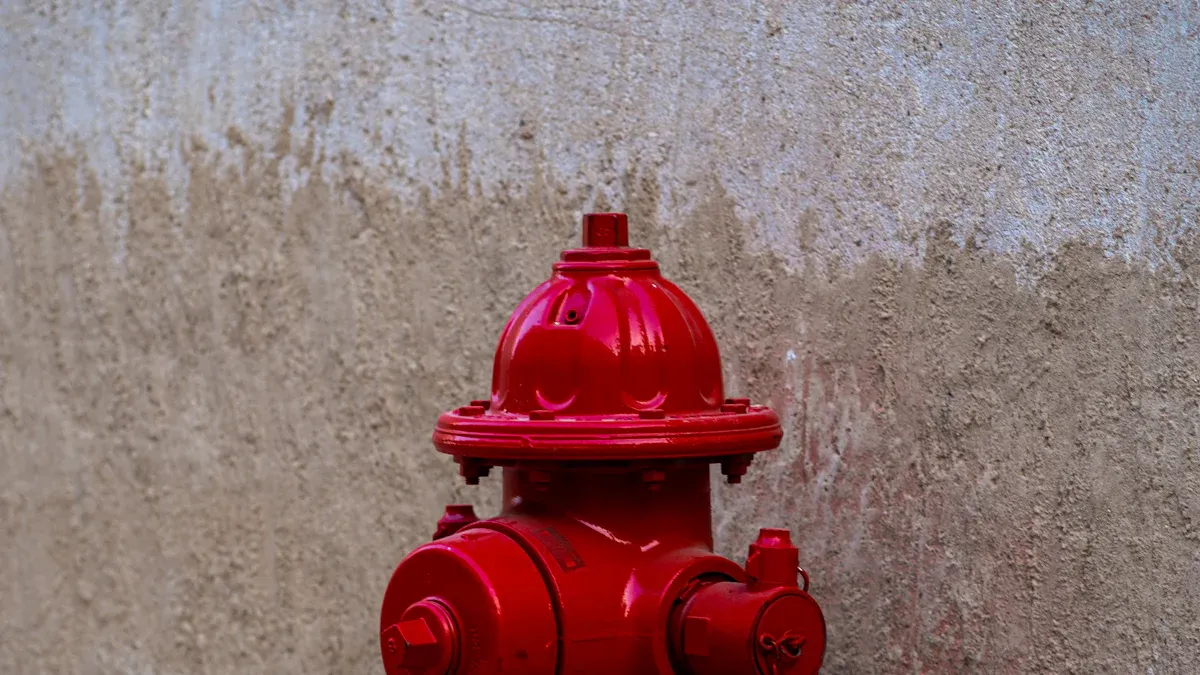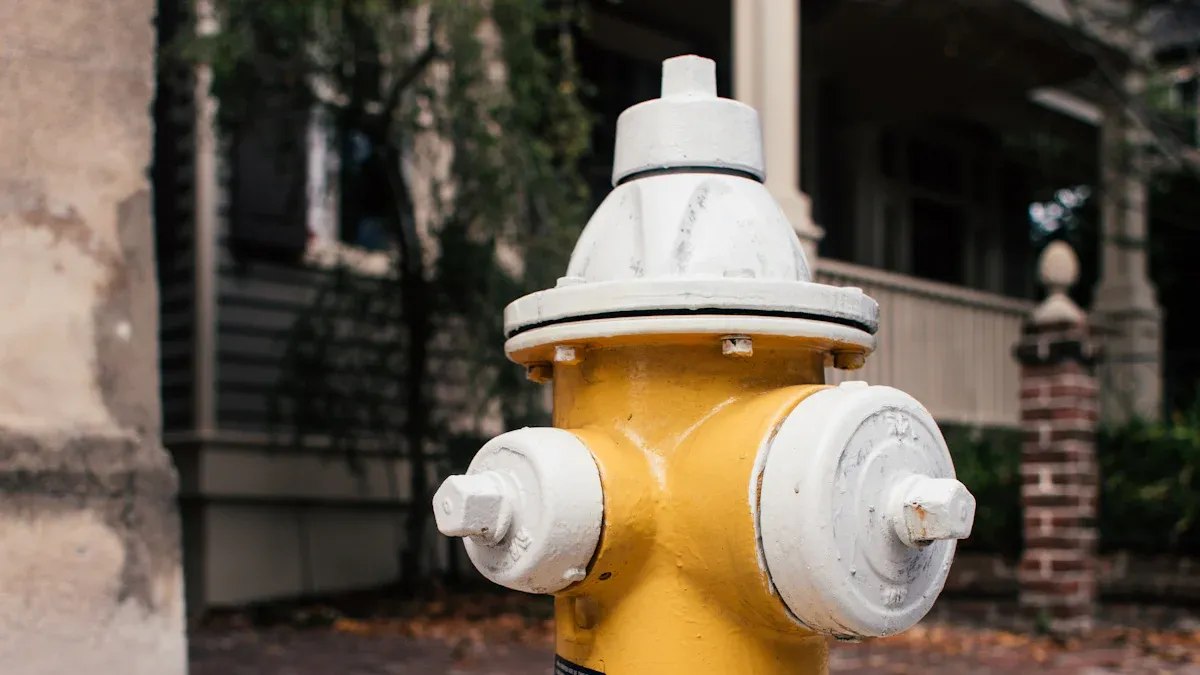

Views: 0 Author: Site Editor Publish Time: 2025-09-10 Origin: Site









You see a fire hydrant on your street. It is an important safety tool. Firefighters use it to get water fast in emergencies. The fire hydrant connects to water pipes underground. This helps firefighters put out fires. It also helps keep buildings safe in your neighborhood.
Fire hydrants are very important for firefighters. They let firefighters get water fast in emergencies. This helps put out fires and saves people.
Fire hydrants need to be checked and fixed often. This makes sure they work right when needed. Cities have to follow safety rules. This keeps hydrants ready for emergencies.
There are two main kinds of fire hydrants: wet and dry. Each kind works best in different weather. They have special parts to stop freezing and keep water moving.

Fire hydrants help keep people safe in your town. Their main job is to give water to stop fires. When there is a fire, firefighters need water right away. The fire hydrant connects to pipes under the ground. This lets firefighters get water fast and with strong pressure. They use this water to fight fires and stop damage.
Fire hydrants are very important for safety. They help protect homes, schools, and stores from fire. In an emergency, firefighters find the hydrant and hook up their hoses. They use pressurized water to put out the flames. This helps them work quickly and save lives.
Fire hydrants also work with other emergency tools in your city. Maps and GPS help workers find the closest hydrant fast. Some new hydrants have hoses already attached and quick-release parts. These features let one person use the hydrant alone. This saves time when fighting fires.
Fire hydrants do more than help with fires. City workers use hydrants for other jobs too. Here are some common extra uses:
Giving water during disasters like floods or earthquakes
Helping clean streets or flush water pipes
Giving water to factories in emergencies
Helping at construction sites for dust control or safety
Cities sometimes use hydrants to check water pressure or clean pipes. These jobs help keep the water system working well. But using hydrants can hurt the environment. If lots of chlorinated water comes out, it can harm fish and other animals. Chlorine lowers oxygen in water, which can hurt wildlife and pollute soil and streams.
Tip: Never open a fire hydrant yourself. Only trained workers and emergency crews should use them.
Fire hydrants also help with city planning and emergency plans. City leaders must pay for hydrant installation and care. The costs can be high, especially in big cities.
Cost Component | Estimated Cost Range |
|---|---|
Price of the Fire Hydrant | $1,000 to $3,000 |
Excavation and Installation | $5,000 to $10,000 |
Special Equipment and Accessories | $500 to $1,500 |
Annual Inspections | $100 to $150 per hydrant |
Regular Maintenance | $300 to $500 per hydrant |
Emergency Repairs | $2,000 to $3,500 per repair |
City officials must plan well to keep hydrants ready for emergencies. This makes sure the fire fighting appliance on your street works when needed.
You might wonder how a fire hydrant system gives water in an emergency. The system connects right to the water pipes under the ground. When firefighters open a hydrant, water comes up from pipes below the street. This water shoots out with strong pressure. That helps firefighters put out fires fast.
Water pressure in a fire hydrant is usually between 20 and 80 psi (pounds per square inch).
The lowest safe pressure is about 20 psi. For the best results, hydrants often give between 50 and 100 psi.
The fire hydrant system needs a steady water supply. If a hydrant leaks or a valve is closed, water flow drops. This can slow down fire fighting and put people and buildings in danger.
If a hydrant does not work, firefighters may lose important time. Blocked hydrants, closed valves, or broken parts make it hard to get water. This can cause more damage and danger during a fire.
Some cities use smart hydrants. These hydrants send real-time data about water pressure and flow. With this technology, workers can fix problems before an emergency. GPS and remote monitoring help crews find and use hydrants faster.
A fire hydrant system has many important parts. Each part helps make sure water flows when needed.
Reservoir: This is the main water source. It can be an underground tank or the city’s water supply.
Hydrant Pump: Pumps move water from the reservoir to the hydrant. Some pumps use electricity, while others use diesel.
Hydrant Pillar: This is the part you see above ground. It is where firefighters connect their hoses. You may see one-way, two-way, or three-way pillars.
Control Panel: This panel lets workers adjust the pump and control water pressure.
Hydrant Box Unit: This box stores hoses, nozzles, and valves needed for fire fighting.
The materials used in hydrants are important too. Most hydrants use ductile iron or cast iron. Ductile iron is stronger and less likely to crack. It also resists rust better than cast iron. Here is a quick comparison:
Property | Ductile Iron | Cast Iron |
|---|---|---|
Strength and Toughness | Very strong and tough, good for high pressure | Strong but more brittle |
Microstructure | Resists cracking, absorbs impacts | More likely to crack |
Corrosion Resistance | Slows down rust with a protective oxide layer | Rusts faster, especially in wet conditions |
Pressure Handling | Handles up to 640 psi | Struggles with high pressure |
Temperature Handling | Works up to 1350°F (730°C) | Less reliable in heat |
A well-made fire hydrant can last up to 50 years. With good care, some hydrants work for over 100 years.
Most cities have two main types of fire hydrants: wet hydrants and dry hydrants. Each type works best in certain weather.
Feature | Wet Barrel Fire Hydrant | Dry Barrel Fire Hydrant |
|---|---|---|
Water Source | Connected to public supply | Direct connection to water source |
Flow Rate | Immediate flow when opened | Lower flow rate |
Common Usage | Residential and urban areas | Rural or agricultural areas |
Freeze Risk | Contains standing water, risk of freezing | No standing water, less likely to freeze |
Cost | Generally less expensive | Typically more expensive |
Maintenance | Requires frequent flushing | Requires regular inspection and flushing |
Contamination Prevention | Risk of contamination due to standing water | Prevents contamination of public water supply |
Wet hydrants always have water inside. When you open one, water comes out right away. These hydrants work best in warm places where pipes do not freeze. You often see wet hydrants in cities and towns with mild winters.
Dry hydrants work in a different way. They do not hold water in the barrel when not in use. A valve below the ground keeps the hydrant dry. When you open a dry hydrant, water rises up only when needed. This design stops water from freezing inside the hydrant. Dry hydrants are best for cold places with freezing winters.
Tip: In cold areas, dry hydrants help stop freeze damage. The valve stays below the frost line, so water never sits in the barrel when it is cold outside.
Both types of fire hydrants are important for fire fighting. The right choice depends on your local weather and water needs. City planners look at climate, cost, and safety when picking which hydrant to use.
You might wonder who looks after the fire hydrant near you. In most towns, the city or local government takes care of public hydrants. They check that each hydrant works and is ready for emergencies. If a hydrant is on private land, the owner must keep it working. Big places like malls or hospitals often have their own hydrants. These owners must follow the same rules as the city for testing and fixing hydrants.
Testing hydrants often makes sure water is ready for firefighters.
Laws say hydrants must be tested and fixed often. Here are some common rules:
NFPA rules and city laws say hydrants need regular checks.
Hydrants must be tested every year and every five years.
Hydrant systems must always work and get fixed if broken.
NFPA 25 says hydrants need to be checked and tested every year.
Testing hydrants helps find leaks, rust, or blockages. Cities keep records of all hydrant tests and repairs. This helps stop problems when there is an emergency.
You cannot use a fire hydrant unless you have special permission. Only city workers or trained crews can open and use hydrants. If you use a hydrant without approval, you could get a fine or even go to jail.
City | Penalty Description | Fine Amount | Jail Time |
|---|---|---|---|
Sebring | Pay for damages if you use a hydrant illegally | $1,000 | N/A |
Topeka | Fines and possible jail time for unauthorized use | Up to $499 | Up to 179 days |
New York | Fines and possible jail time for illegal hydrant use | Up to $1,000 | Up to 30 days |
Never try to open a hydrant yourself. It is not allowed and can be dangerous.
Private fire hydrants are on land owned by businesses or big properties. You might see them at warehouses, malls, or hospitals. The owner must pay for testing and repairs. These hydrants must follow the same safety rules as public ones. Testing makes sure private hydrants work as well as city hydrants during a fire.
You understand why a fire hydrant is important.
Fire hydrants let firefighters get water quickly to fight fires.
Checking hydrants often helps them stay ready for emergencies.
These systems help keep people safe and protect buildings.
Safety rules make sure each hydrant works when it is needed.
Report it to your city’s water department or fire department. Quick reporting helps keep your neighborhood safe.
You need permission from your local government. Unauthorized painting can hide important markings and make hydrants hard to find.
Firefighters test hydrants to check water pressure and flow. These tests help make sure hydrants work during emergencies.
